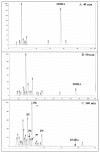Photochemical reaction of 7,12-dimethylbenz[a]anthracene (DMBA) and formation of DNA covalent adducts
- PMID: 16705809
- PMCID: PMC3814705
- DOI: 10.3390/ijerph2005010114
Photochemical reaction of 7,12-dimethylbenz[a]anthracene (DMBA) and formation of DNA covalent adducts
Abstract
DMBA, 7,12-dimethylbenz[a]anthracene, is a widely studied polycyclic aromatic hydrocarbon that has long been recognized as a probable human carcinogen. It has been found that DMBA is phototoxic in bacteria as well as in animal or human cells and photomutagenic in Salmonella typhimurium strain TA102. This article tempts to explain the photochemistry and photomutagenicity mechanism. Light irradiation converts DMBA into several photoproducts including benz[a]anthracene-7,12-dione, 7-hydroxy-12-keto-7-methylbenz[a]anthracene, 7,12-epidioxy-7,12-dihydro-DMBA, 7-hydroxymethyl-12-methylbenz[a]anthracene and 12-hydroxymethyl-7-methylbenz[a]anthracene. Structures of these photoproducts have been identified by either comparison with authentic samples or by NMR/MS. At least four other photoproducts need to be assigned. Photo-irradiation of DMBA in the presence of calf thymus DNA was similarly conducted and light-induced DMBA-DNA adducts were analyzed by 32P-postlabeling/TLC, which indicates that multiple DNA adducts were formed. This indicates that formation of DNA adducts might be the source of photomutagenicity of DMBA. Metabolites obtained from the metabolism of DMBA by rat liver microsomes were reacted with calf thymus DNA and the resulting DNA adducts were analyzed by 32P-postlabeling/TLC under identical conditions. Comparison of the DNA adduct profiles indicates that the DNA adducts formed from photo-irradiation are different from the DNA adducts formed due to the reaction of DMBA metabolites with DNA. These results suggest that photo-irradiation of DMBA can lead to genotoxicity through activation pathways different from those by microsomal metabolism of DMBA.
Figures








Similar articles
-
Photochemical Reaction of 7,12-Dimethylbenz[a]anthracene (DMBA) and Formation of DNA Covalent Adducts.Int J Environ Res Public Health. 2005 Apr;2(1):114-122. Int J Environ Res Public Health. 2005. PMID: 24187532
-
Mechanism of metabolic activation of the potent carcinogen 7,12-dimethylbenz[a]anthracene.Chem Res Toxicol. 1992 Mar-Apr;5(2):220-6. doi: 10.1021/tx00026a011. Chem Res Toxicol. 1992. PMID: 1643251
-
Tissue distribution of DNA adducts in rats treated by intramammillary injection with dibenzo[a,l]pyrene, 7,12-dimethylbenz[a]anthracene and benzo[a]pyrene.Mutat Res. 1997 Aug 1;378(1-2):31-9. doi: 10.1016/s0027-5107(97)00095-x. Mutat Res. 1997. PMID: 9288883
-
Formation of benzylic-DNA adducts resulting from 7,12-dimethylbenz[a]anthracene in vivo.Chem Res Toxicol. 2005 Apr;18(4):686-91. doi: 10.1021/tx049686p. Chem Res Toxicol. 2005. PMID: 15833028
-
Specificity of cDNA-expressed human and rodent cytochrome P450s in the oxidative metabolism of the potent carcinogen 7,12-dimethylbenz[a]anthracene.Mol Carcinog. 1996 Dec;17(4):241-9. doi: 10.1002/(SICI)1098-2744(199612)17:4<241::AID-MC8>3.0.CO;2-G. Mol Carcinog. 1996. PMID: 8989918
Cited by
-
Photoirradiation of polycyclic aromatic hydrocarbons with UVA light - a pathway leading to the generation of reactive oxygen species, lipid peroxidation, and dna damage.Int J Environ Res Public Health. 2006 Dec;3(4):348-54. doi: 10.3390/ijerph2006030045. Int J Environ Res Public Health. 2006. PMID: 17159277 Free PMC article. Review.
-
UVA photoirradiation of oxygenated benz[a]anthracene and 3-methylcholanthene--generation of singlet oxygen and induction of lipid peroxidation.Int J Environ Res Public Health. 2008 Mar;5(1):26-31. doi: 10.3390/ijerph5010026. Int J Environ Res Public Health. 2008. PMID: 18441402 Free PMC article.
-
Murine Models of Obesity-Related Cancer Risk.Cancer Prev Res (Phila). 2025 Sep 2;18(9):509-529. doi: 10.1158/1940-6207.CAPR-24-0545. Cancer Prev Res (Phila). 2025. PMID: 40509936 Free PMC article. Review.
-
Hepatic dysfunction induced by 7, 12-dimethylbenz(α)anthracene and its obviation with erucin using enzymatic and histological changes as indicators.PLoS One. 2014 Nov 12;9(11):e112614. doi: 10.1371/journal.pone.0112614. eCollection 2014. PLoS One. 2014. PMID: 25390337 Free PMC article.
-
Light-Induced Toxic Effects of Tamoxifen: A Chemotherapeutic and Chemopreventive Agent.J Photochem Photobiol A Chem. 2009 Jan 1;201(1):50-56. doi: 10.1016/j.jphotochem.2008.09.013. J Photochem Photobiol A Chem. 2009. PMID: 20046228 Free PMC article.
References
-
- Dipple A., Moschel R. C., Bigger C. A. H. Polynuclear aromatic carcinogens. In: Searle C. E., editor. American Chemical Society Monograph 182. Chemical Carcinogens. Vol. 1. American Chemical Society; Washington, DC: 1984. pp. 41–163.
-
- Yang S. K., Silverman B. D., editors. Polycyclic Aromatic Hydrocarbon Carcinogenesis: Structure-Activity Relationships. I and II CRC Press; Boca Raton, FL: 1988.
-
- Harvey R. G. Polycyclic Aromatic Hydrocarbons. Wiley-VCH; New York: 1997.
-
- Conney A. H. Induction of Microsomal Enzymes by Foreign Chemicals and Carcinogenesis by Polycyclic Aromatic Hydrocarbons. Cancer Res. 1982;42:4875–4917. - PubMed
-
- Arfsten D. P., Schaeffer D. J., Mulveny D. C. The effects of near ultraviolet radiation on the toxic effects of polycyclic aromatic hydrocarbons in animals and plants: A review. Ecotoxicol. Environ. Safety. 1996;33:1–24. - PubMed
Publication types
MeSH terms
Substances
Grants and funding
LinkOut - more resources
Full Text Sources
